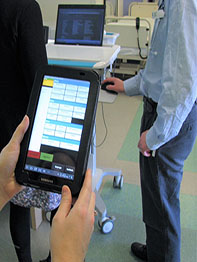WOMBAT case studies
Work patterns in renal nutrition
This study was conducted by Assistant Professor Rosa K. Hand and colleagues in the Department of Nutrition, School of Medicine at Case Western Reserve University in Cleveland, Ohio, USA.
Like other health professionals, there are concerns about registered dietitian burnout and workload. In the US, dialysis is a unique healthcare environment because a) most dialysis is paid for by the Centers for Medicare and Medicaid Services and b) a registered dietitian is a required member of the interdisciplinary team and has the ability to establish long-term relationships with patients. However, dietitians self-report that they are being asked to take on more and more administrative and documentation responsibilities, limiting the time for behavior change counseling.
This study used a newly developed WOMBAT template to quantify these patterns. In a small sample, we demonstrated that WOMBAT can be used with allied health professionals like dietitians and in outpatient settings like dialysis.
Our findings about the proportion of time spent in direct care (25%), communication (20%) and transit (7%) have surprising similarity to those described in med/surg nurses using WOMBAT methodology previously (Westbrook et al 2009).
These results were published in the Journal of Renal Nutrition.
Physician time in ambulatory care
This case study was undertaken in the USA where a new study template was devised to look at physician time in ambulatory care settings.
Following the results of a large survey, which revealed signs of burnout and growing dissatisfaction with work-life balance amongst US physicians, the American Medical Association were interested in quantifying how physicians in ambulatory care spend their time. In collaboration with the Dartmouth-Hitchcock Medical Center and the Centre for Health Systems and Safety Research, Macquarie University, the researchers undertook a WOMBAT study of 57 physicians working in 4 specialties (family medicine, internal medicine, cardiology, and orthopaedics) across 4 states (Illinois, New Hampshire, Virginia, and Washington).
A physician work task study template for ambulatory care was devised, which included 12 broad work task categories grouped under four key activities: direct clinical face time; electronic health record (EHR) and desk work; administrative tasks; and other tasks. Ten medical students were trained regarding the study template classification definitions and how to use WOMBAT. The students undertook 430 hours of observation of ambulatory physicians’ work.
 The findings showed that during office hours, ambulatory care physicians spent nearly half their time on EHR and desk work activities and less than one third on direct clinical face time with patients; in other words, for every hour of direct clinical face time with patients, physicians spent almost 2 hours on EHR and desk work. Such findings provide critical information in characterising the ambulatory care domain regarding what work is done and for how long. Using WOMBAT allowed the researchers to describe ambulatory physicians’ time distribution objectively, capturing work and interactions both with and without electronic devices, and provided a broader view of the role and use of the EHR in the ambulatory environment.
The findings showed that during office hours, ambulatory care physicians spent nearly half their time on EHR and desk work activities and less than one third on direct clinical face time with patients; in other words, for every hour of direct clinical face time with patients, physicians spent almost 2 hours on EHR and desk work. Such findings provide critical information in characterising the ambulatory care domain regarding what work is done and for how long. Using WOMBAT allowed the researchers to describe ambulatory physicians’ time distribution objectively, capturing work and interactions both with and without electronic devices, and provided a broader view of the role and use of the EHR in the ambulatory environment.
The study was published in Annals of Internal Medicine.
Work patterns of intensive care unit doctors
 This case study was undertaken by a research team in Australia used an existing work study template (previously applied in studies looking at doctors on wards and in emergency departments) to examine the work of intensive care doctors.
This case study was undertaken by a research team in Australia used an existing work study template (previously applied in studies looking at doctors on wards and in emergency departments) to examine the work of intensive care doctors.
The intensive care unit (ICU) is known to be a complex environment, where clinicians care for some of the most acutely ill patients in hospital. Decision making in intensive care is also multifaceted and involves collaboration between ICU doctors, medical teams from other specialties, as well as multiple information elements including flow charts, patient notes, medication charts, vital signs, test results, and images. The aim of this study was to measure how ICU doctors spend their time, what information resources they use to assist their work, with whom they work, and how often they multitask or are interrupted. A secondary aim was to compare the work patterns of ICU doctors with those of doctors on general wards and in emergency departments from previously published WOMBAT studies.
The study was conducted in two ICUs at two major teaching hospitals in Sydney and involved 26 doctors. Two observers used an existing WOMBAT study template and task classification to record over 160 hours of observation. The findings showed that ICU doctors spent 69% of time working at patients’ bedsides, 50% of time in professional communication, and 39% of time accessing information resources. Over half (54%) of their time was spent with other ICU doctors and 29% with nurses. ICU doctors had a high multitasking rate (40 times per hour) and were interrupted 4 times per hour.
Compared with doctors on general wards and emergency departments, ICU doctors spent more time in professional communication, more time with patients, and more time with nurses. ICU doctors were also more likely to multitask. By using a study template and work task classification used in previous WOMBAT studies, the researchers were able to demonstrate how ICU doctors manage their time and work demands compared with their colleagues on general wards and in emergency departments. Using WOMBAT allowed the researchers to quantify the more complex environment of the ICU, which necessitates high levels of multitasking and interdisciplinary collaboration to care for acutely ill patients.
The study was published in Critical Care and Resuscitation.
